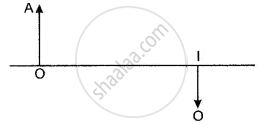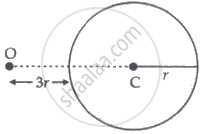Advertisements
Advertisements
प्रश्न
A diverging lens of focal length 20 cm and a converging lens of focal length 30 cm are placed 15 cm apart with their principal axes coinciding. Where should an object be placed on the principal axis so that its image is formed at infinity?
उत्तर
Given,
Focal length of convex lens, fc = 30 cm
Focal length of concave lens, fd = 15 cm
Distance between both the lenses, d = 15 cm
Let (f) be the equivalent focal length of both the lenses.\[\frac{1}{f} = \frac{1}{f_1} + \frac{1}{f_2} - \frac{d}{f_1 f_2}\]
\[ = \frac{1}{30} + \left( \frac{1}{20} \right) - \left( \frac{5}{30( - 20)} \right)\]
\[ = \frac{1}{120}\]
\[\Rightarrow f=120 \text{ cm }\]
As focal length is positive, so it will be a converging lens.
Let 'd1' be the distance from diverging lens, so that the emergent beam is parallel to the principal axis and the image will be formed at infinity.
\[d_1 = \frac{df}{f_c} = \frac{15 \times 120}{30} = 60 \text{ cm }\]
It should be placed 60 cm left to the diverging lens. The object should be placed
(120 − 60) = 60 cm from the diverging lens
Let d2 be the distance from the converging lens. Then,
\[d_2 = \frac{df}{f_d} = \frac{15 \times 120}{20}\]
d2 = 90 cm
Thus, it should be placed (120 + 90) cm = 210 cm right to converging lens.
APPEARS IN
संबंधित प्रश्न
Define 1 dioptre of power of a lens.
Consider two statements A and B given below:
A: real image is always inverted
B: virtual image is always erect
Out of these two statements:
Which type of lens has (a) a positive power, and (b) a negative power?
How is the power of a lens related to its focal length?
A converging lens has focal length of 50 mm. What is the power of the lens?
The power of a lens is + 0.2 D. Calculate its focal length.
The power of a combination of two lenses X and Y is 5 D. If the focal length of lens X be 15 cm :
(a) calculate the focal length of lens Y.
(b) state the nature of lens Y.
What is the unit of power of a lens? Define the unit of power of a lens.
A combination of lenses for a camera contains two converging lenses of focal lengths 20 cm and 40 cm and a diverging lens of focal length 50 cm. Find the power and focal length of the combination.A optical instrument in which the above arrangement of convex lens is used is a convex lens used to burn paper by focusing sunlight.
State the condition for the following a lens has both its focal lengths equal .
State the condition for the following a ray passes undeviated through the lens .
How is the power of a lens related to its focal length?
A double convex lens has two surfaces of equal radii R and refractive index \[m = 1 \cdot 5\]
How is accommodation produced?
The following diagram shows the object O and the image I formed by a lens. Copy the diagram and on it mark the positions of the lens LL’ and focus (F). Name the lens.

If focal length of a convex lens is 20 cm at what is the power of the lens?
A point object is placed at O in front of a glass sphere as shown in figure.

Show the formation of the image by the sphere.
The same size images are formed by a convex lens when the object is placed at 20 cm or at 10 cm from the lens. The focal length of convex lens is ______ cm.
An object is kept at a distance of 1m from a lens of power +2D:
- Identify the type of lens.
- Calculate its focal length and distance of the image formed.
